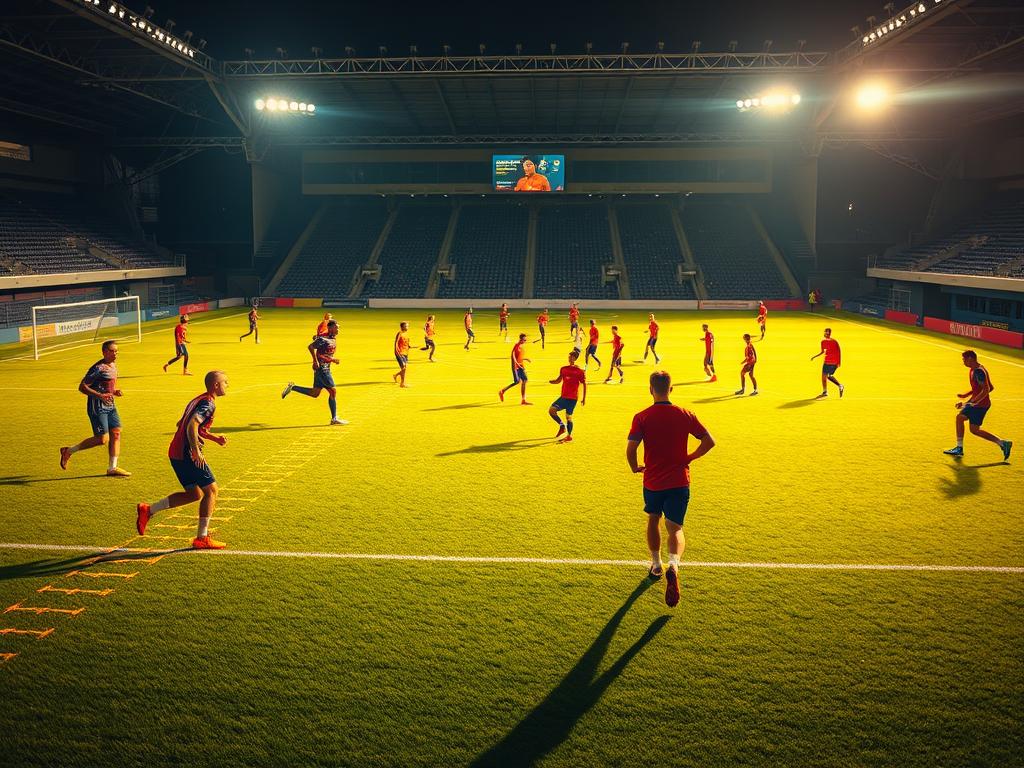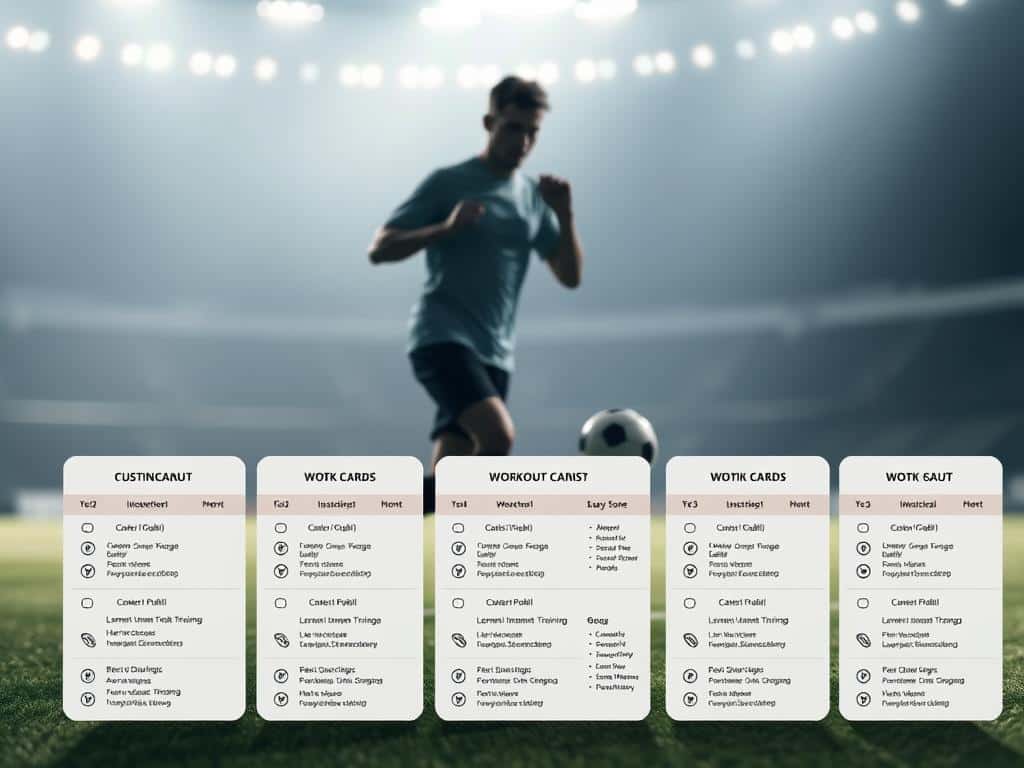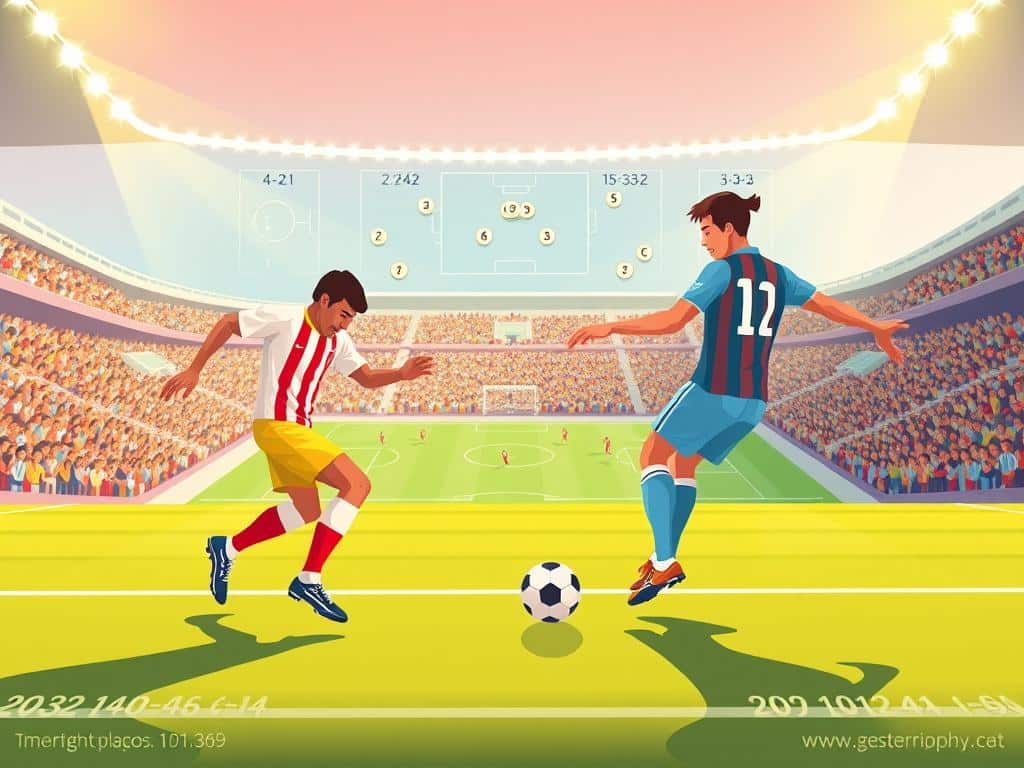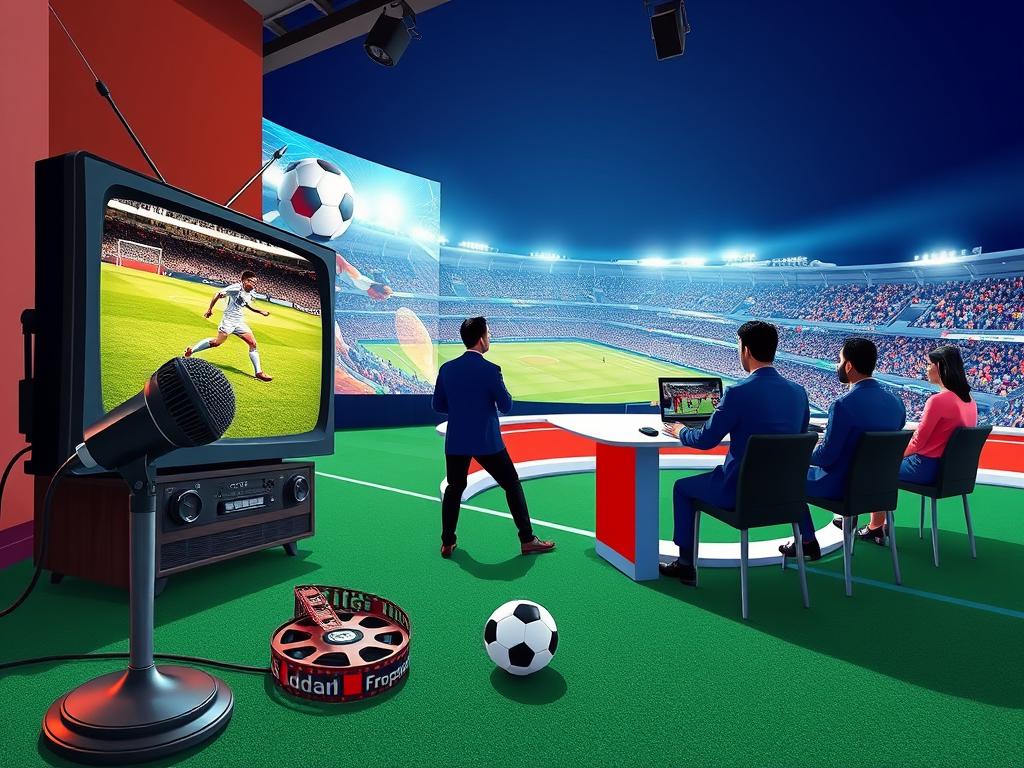Did you know pro players cover about 6–8 miles per match, with nearly 90% of that movement at easy speeds and only 10–20% in hard bursts? That’s the scale of work that decides late-match winners and losers.
This introduction shows you a clear way to build match-ready stamina without guessing. You get a simple, science-backed approach that links what you do in sessions to how you feel on the field.
Expect focused work on steady aerobic base and short high-intensity efforts so a player can keep form, protect the ball, and sprint cleanly when it counts.
Whether you train solo or with a squad, the program emphasizes practical steps: measured intervals, repeatable sessions, and strength that helps hold form under fatigue.
Key Takeaways
- Pro players cover 6–8 miles—most movement is aerobic, with brief anaerobic bursts.
- Smart sessions shift the lactate curve and delay fatigue for better late-game output.
- This program blends steady work, high-intensity reps, and strength for real benefits.
- Tools are simple: clear progressions you can add to your week without guesswork.
- Every drill has a purpose—each rep builds match-ready fitness and decision clarity.
Why Endurance Wins Games: Aerobic base, anaerobic bursts, and late-match performance
A match is mostly long, steady movement punctuated by brief, explosive efforts. That mix shapes who finishes strong and who fades.
Across 90 minutes, pros average 6–8 miles, with about 80–90% covered under 9 mph — mostly aerobic work. The rest is fast running and sprints powered anaerobically. Those bursts create the decisive moments in games.
Aerobic vs. anaerobic work in a 90-minute match
Aerobic work builds your oxygen economy. Anaerobic work is the high-octane fuel for presses, recoveries, and match-winning sprints. You need both to control late match phases.
Lactate tolerance and delaying fatigue
- When lactate rises faster than you clear it, performance drops quickly.
- Smart training shifts the lactate curve, so repeated accelerations feel easier for longer.
- Use heart rate zones, tempo runs, and strength work to protect form, help muscles, and extend your ability into the final minutes.
Assess First, Then Train: Baseline tests and fitness markers
Before you start any block, measure where you stand. Simple checks give clear targets and stop wasted weeks.
Heart rate zones and simple field tests
Begin by finding basic heart rate zones: easy base, steady threshold, and sharp intervals. These zones make every session purposeful.
Use cheap, home-friendly tools—cones, a wall, resistance bands, and a jump rope—to run repeatable tests. Try a 5–10-20 shuttle, a timed 1-mile, or repeated 60-second efforts with set rest. Track times and perceived effort.
- Repeatable tests show real development, not random good days.
- Match your program to your level. Push enough to adapt, not so hard you crash.
- Keep quick workout notes: distance, reps, and how the session felt.
- Treat assessment as preparation—data guides the next block and keeps progress steady.
| Test | What it shows | How often |
|---|---|---|
| Timed 1-mile | Aerobic pace and recovery | Every 4 weeks |
| Controlled shuttles | Repeated-sprint capacity | Every 2–3 sessions |
| 60s max effort | Threshold work and heart rate response | Every 3–4 weeks |
You want a feedback loop: test, train, re-test. That cycle speeds development and keeps preparation focused. Own your numbers; they become the roadmap for smarter workouts and better sessions.
soccer endurance training plan
Build the base, layer intensity, then sharpen repeatability. Start with steady minutes to raise aerobic capacity, then add shorter, harder intervals to develop anaerobic power. That mix improves recovery between high-speed efforts during a match.
Each week pairs conditioning with ball work and simple drills that mirror play: accelerate, slow, change direction, then go again. This keeps gains on the ball, not just on a stopwatch.

- Roadmap: base → intensity → repeatability so you can surge late in a match.
- Cycle volume and density by level so time and load rise safely as your ability improves.
- Keep strength in the mix to protect joints and maintain mechanics under fatigue.
- Expect performance gains when sessions match real game demands—targeted, not random.
Follow the progression and you’ll see measurable change. Plan the work, track sessions, and let consistent effort elevate your soccer performance.
Warm-Up the Right Way: Prime the heart, muscles, and movement patterns
Start smart: ten minutes of movement can change how you perform all session. Begin with light jogging for 10–15 minutes to raise body temperature and steady the breath. This simple step reduces injury risk and makes power feel cleaner.
Follow with dynamic mobility: high knees, grapevine steps, and controlled strides. Keep each drill crisp and focused. These moves wake up hips, hamstrings, and core.
Dynamic mobility, activation, and ball-touch ramp-up
- Elevate heart rate first, then add mobility to prime joints and muscles.
- Layer in agility patterns and short accelerations to groove change-of-direction and power.
- Add ball touches—inside/outside, sole rolls, quick taps—to sync footwork and focus.
- Match the warm-up to the main set: stair sessions need knee drive; change drills need ankle prep.
- Keep it short: in minutes you’ll feel smoother strides and better control for the first rep.
Result: a sharper, safer start where your body and brain move together. That preparation makes every rep count.
Build the Engine: Field conditioning drills that mirror real match demands
Turn the pitch into a testing ground: drills that force sprinting, braking, and ball control under pressure. These sessions build the power and repeatability you need late in games.
Shuttle runs with cone touches
Set three cones 20–30 yards apart. Sprint 1→2→1, then 1→3→1 for one rep. Do 5 reps (~500 yards), rest 5 minutes, then repeat. Focus on sharp turns and clean cone touches.
Stop‑go intervals
Lap the field: sprint corner to halfway at 100%, jog to the corner at 50%, then jog the goal line. Keep this up for 30–45 minutes to mimic match flow.
Stairs and hill work
After a 10–15 minute warm-up, run stairs 30s up, walk down; 5 reps, 2 minutes rest, repeat. For hills, follow the 5×1:00, 5×45s, 3×30s structure with jog‑down and 3 minutes rest between sets.
Dribble‑and‑run & core
Dribble from touchline cone A, leave ball halfway, sprint to cone B, loop and return. Six reps with 1 minute rest. Finish with planks: 1 minute holds, 30s rest, total 5 minutes. Progress forearm, side, and walking planks to build trunk strength.
- Focus cues: eyes up, quick feet, sharp turns.
- Track minutes and rest precisely to nudge density safely.
| Drill | Setup | Reps | Rest |
|---|---|---|---|
| Shuttle runs | 3 cones, 20–30 yd | 5 reps per set (~500 yd) | 5 minutes between sets |
| Stop‑go circuit | Full field lap | 30–45 minutes continuous | Active jog recovery |
| Stairs / Hills | Stairs or 3-min hill | 5×30s stairs; hill: 5×1:00, 5×45s, 3×30s | 2–3 minutes between sets |
| Dribble & planks | Touchline cones + ball | 6 dribble reps; 5 min total planks | 1 min dribble rest; 30s plank rest |
Weekly Structure Players Can Stick To: A practical training schedule
A clear weekly rhythm turns scattered work into steady gains. This short guide shows how to pair technical drills with conditioning, add recovery, and sharpen speed so you show up ready for the big day.
Technical + conditioning pairing
Monday: Ball mastery, cone patterns, and short intervals. Pair skill reps with 15–25 minutes of conditioning so technique holds under fatigue.
Strength, mobility, and active recovery
Tuesday: Bodyweight strength and mobility. No gym needed. Keep sets controlled and joints happy.
Wednesday: Tactical review and active recovery: light jog, foam rolling, breathing work to aid recovery and thinking.
Speed, agility drills, and first-touch sessions
Thursday: Short sprints, wall passes, and quick feet. Emphasize acceleration and first touch under pressure.
Match simulation and full rest
Friday: Ball mastery plus a conditioning circuit. Saturday: Full-session match simulation. Sunday: True rest or light yoga and visualization.
| Day | Main focus | Gear |
|---|---|---|
| Monday | Technical + intervals | Cones, ball |
| Tuesday | Strength & mobility | Bands, bodyweight |
| Thursday | Speed & first touch | Ladder or tape, wall |
| Saturday | Match simulation | Full session setup |
- Anchor your week by pairing touches and conditioning early.
- Keep recovery days honest. They fix gains and protect players.
- Simple gear—cones, bands, a wall—turns any space into a reliable fitness setup.
Progression, Volume, and Rest: How to advance without burning out
Progress happens when you shift volume and recovery with purpose—not by guessing each session. Keep changes small and measurable. Build minutes, then tighten recovery, then lift pace only when form stays clean.
Work‑rest ratios and session design
Start with volume: lengthen moderate work before pushing speed. Stop‑go intervals can run 30–45 minutes continuous to mirror match flow, but only when mechanics remain sharp.
Reps, hills, and level progressions
- Use fixed rep ladders on hills and stairs: longer uphill runs move to shorter, faster reps with set jog‑downs.
- Keep work‑rest honest so quality stays high; your level dictates how fast you tighten ratios.
- If form slips, back off—ability grows fastest when exercises stay crisp, not sloppy.
| Focus | Example | Goal |
|---|---|---|
| Volume | 30–45 min stop‑go | Improve aerobic base |
| Intensity | Hill ladders 5×1:00 → 5×30s | Boost repeat power |
| Recovery | Fixed rest, jog‑down | Protect muscle and body |
Remember: one great workout doesn’t make a week. Track simple markers—same reps with less strain or same work in fewer minutes—to confirm progress. Respect rest and let sessions stack into real gains.
Soccer-Specific vs. General Endurance: Train both for complete performance
Start broad, then get specific. General work builds aerobic capacity, steadier heartbeats, and faster recovery between efforts. That base cuts injury risk and keeps you available all season.
Then add sport-like efforts. Layer in explosive sprints, dribbling under pressure, tempo shifts, and powerful shots. Those movements teach you to perform the moments that decide a match.
- General work = better oxygen use and faster between-effort recovery.
- Soccer-specific work = short stops, starts, and tempo changes that mirror the game.
- Blend both and your performance climbs: you last longer and explode harder when it matters.
| Focus | What it builds | When to emphasize |
|---|---|---|
| General aerobic | Capacity, recovery, injury resistance | Off-season and early pre-season |
| Specific drills | Explosive movements, decision speed | Late pre-season and competitive weeks |
| Balanced program | Reliable match performance across 90+ minutes | In-season maintenance |
Development isn’t either/or. It’s layering targeted work on a solid base. A player who balances both reads the field calmly and still has a kick for the final sprint.
Tools, Space, and Setup: Cones, hills, stairs, and small-area solutions
Small gear, clever layouts, and a short patch of turf can replace a full stadium for high-quality work. You can set up meaningful sessions in a parking lot, a backyard, or a tiny field corner.
Minimal equipment, maximum conditioning impact
Essential kit: cones or bottles, a wall or rebounder, resistance bands, a foam roller, a jump rope, and ladder tape. Hills and stairs add free resistance when a full field isn’t available.

- No stadium? No problem—use cones, a wall, and a small field patch to create serious pathways.
- Hills and stairs boost power and strength the budget-friendly way; they demand short, hard efforts and controlled decels.
- Map lanes with clear cone spacing so change-of-direction drills feel organized and game-like.
- Add quick-foot agility drills with ladder tape to prime coordination before the main workout.
- Keep a compact kit—bands, jump rope, foam roller—to prep and recover anywhere you go.
- Work ball touches into tight spaces so quality carries over when you open up on the field.
| Setup | Purpose | Best use |
|---|---|---|
| Cones + small field patch | Change-of-direction, sprints | Drills that mimic match lanes |
| Hills / Stairs | Power, strength, controlled decel | Short reps, jog-down recovery |
| Wall / Rebounder | Ball work under fatigue | Combine touch work with short runs |
Bottom line: choose setups that make strength and soccer meet—short uphill bursts, then controlled decels back down. It’s a smart, portable system that keeps you training no matter the conditions.
Coaches’ Corner: Cues, heart rate focus, and session goals on the field
Clear, short coaching cues turn messy reps into sharp, reliable actions. Say one instruction at a time. Players respond faster. Results show up in minutes, not weeks!
Before each session, name the goal: pace, reps, or technique. Track timing and rest intervals so improvements are measurable.
Shuttle runs use three cues: eyes up, stick the cone, re-accelerate. Stairs demand tall posture and ball-of-foot landings. Planks need a straight line, neutral head, and a belly pulled to the spine.
Keep exercises crisp. Quality planks and clean direction changes beat sloppy volume every time. Build in recovery so players finish sessions ready for more.
- Set a simple cue for each drill and repeat it before every rep.
- Use heart rate or perceived effort to guide session intensity.
- Log every session and compare week to week for real motivation.
| Focus | Coach cue | How to measure |
|---|---|---|
| Shuttle runs | “Eyes up — stick the cone — go” | Even splits per rep, stopwatch |
| Stairs | “Tall posture — land on forefoot” | Reps completed with clean form |
| Planks | “Neutral head — belly tight” | Hold time without hip drop |
Finish Strong: Turn consistent training into game-day stamina and confidence
Finish Strong: Turn consistent training into game-day stamina and confidence
Want to finish matches with energy and calm decision-making in the final minutes? Stack steady aerobic work with repeat sprints—shuttles, stop‑go intervals, stairs and hills—and add dribble‑and‑run sets and core planks. This combo builds the capacity to sustain high output deep into a game.
Consistency is your superpower. Players who keep simple, repeatable sessions develop late-match strength, speed, and cleaner touch on the ball. Respect recovery; it’s part of the work.
Trust the program, track small wins—cleaner hills, steadier planks, sharper sprints—and watch your body show up ready to close plays with belief and power.







